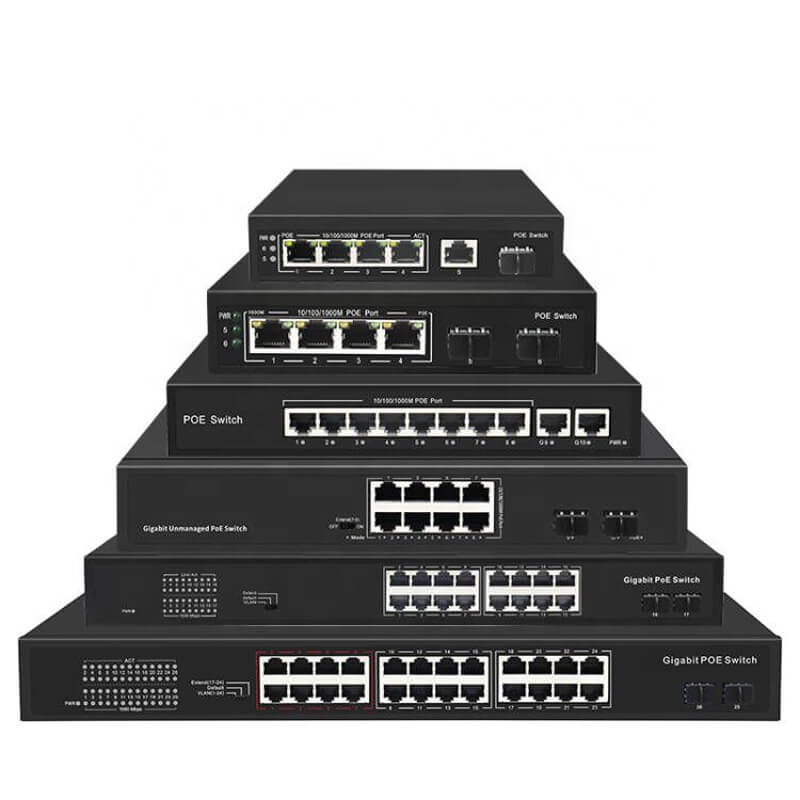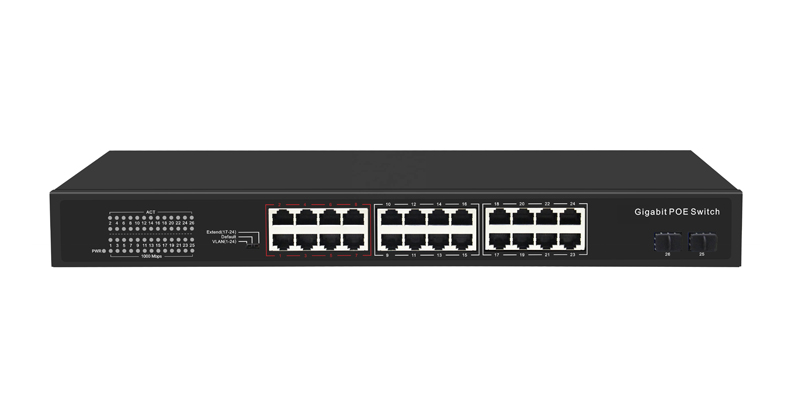Everything You Want to Know About POE Switch 16 Port
2022.02.20 / By Sailsky
PoE standards and compatibility
POE switch 16 ports have evolved over time, delivering ever higher power to meet the demands of new applications. This has resulted in a complex variety of PoE products, both standards-based and pre-standard implementations. These multiple implementations differ in functionality. It offers voltage levels, power levels, power management, and classification.

Selecting the right equipment falls on the consumer
Due to the wide variety of PSE and PD equipment on the market. The burden of selecting the right equipment and checking compatibility falls on the consumer. PD devices require higher electrical power, such as heated PTZ cameras for outdoor surveillance systems. They characterize by varying power requirements, such as standby and active states.
The four types of POE switch 16 ports are defined by the IEEE standard list below. The new IEEE 802.3bt standard provides the highest maximum power level suitable for powering kiosks and lighting. There are also non-standard PoE implementations, such as supplying 12 or 24 VDC power for vendor-specific security cameras and access points.
PoE Deployment must be considered
The overall benefit of PoE technology is that it makes it easier to deploy network-connected devices. When deploying a PoE system, delivery principles, types/classes, and power management must consider.
Electricity delivery in POE switch 16 port-enabled devices
PoE-enabled devices use two or four twisted pairs of standard Ethernet cables to provide DC power. PoE power applies across the data wires by applying a common mode voltage to each pair. Since twisted-pair Ethernet uses differential signalling for data transmission. This will not interfere with data transmission as long as the following rules observe:
- PoE power supplies over a twisted-pair cable through an RJ45 connector according to the wiring diagram defined in the IEEE 802.3 Ethernet standard.
- The voltages on the two conductors in a pair have the same level and polarity.
- PoE power is subject to the same distance limits as a standard cable duct: 100 meters or 328 feet.
If only two of the four pairs use to supply POE switch 16 port power, and these are pairs 1-2 and 3-6, this scheme calls Alternative A in the IEEE standard. Since only two of the four pairs need for 10BASE-T or 100BASE-TX, the power supply can transmit over unused cable conductors, such as 4-5 and 7-8.
This is called Alternative B in IEEE standards
PoE can also use with 1000BASE-T and 10GBase-T Ethernet standards when all four pairs are used for data transmission. Allowing higher electrical power to transmit, the POE switch 16 port use all four pairs of cable for both power and data.
The following table shows in detail how power supplies in pairs. The pairs on which the electrical power will transmit determine by the PSE source.
It is tempting to move the distance boundary beyond the 100 meters specified by the IEEE standard when the only alternative is to add AC power at the PD or intermediate switch/injector. Although not recommended, the network tester allows you to test the data link and, in these circumstances, the maximum power is still available.
POE switch 16 port types and classes
PoE standards have evolved over time to meet the growing power needs of powered devices (PDs). Created in 2003, the original IEEE 802.3af standard provides up to 13W of DC power to each device. Updated in 2009, the IEEE 802.3at standard, also known as PoE Plus (PoE+), provides electrical power up to 25.5W.
Sailsky own implementation of UPOE used all four cable pairs to increase the electrical power on the PD to 51 W. With the adoption of the IEEE 802.3bt standard, there are now nine possible power classes for the four PSE source classes. Various handshaking and negotiation schemes use to recognize power requirements and capabilities between PSEs and PDs.
Many POE switches 16 ports – support less power
On many PSE sources, the maximum available power of the device itself limits the total number of ports through which power can supply. For example, Class 4 PDs require 30W of PSE source output, while a 48-port Type 2 PoE switch must support up to 1440W.
Adding 802.3bt and 90 watts per PSE source port would require 4320 watts of electrical power for just the PoE part of the switch. Many PoE-enabled switches support less power, making power management necessary. Power management makes it harder to move, add, change, and troubleshoot. Some PSE sources allow you to set different priority levels for each port.

Check the requested power to be provided
When a POE switch 16 port connects to the PSE source, The PSE checks its class and reserves certain power from its available electrical power reserve. When the PSE source reaches its power limit, the next PD that requests more power than is available on the PSE source can still connect if the connect port has a higher priority than the other ports.
The only way to ensure that the requested power can provide to the port is to check it.
There are many points where POE switch 16 port power can fail
These are the ports of switches and PoE injectors, as well as in the Ethernet network itself. Moreover, many cable infrastructures existed before the deployment of PoE technology or using only the low-power 802.3af standard.
By using two additional pairs and increasing the current to 960 mA per pair, the electrical power available to PD devices is five times higher than that of the 802.3af standard. And that speaks to using cable infrastructure like never before.
The PoE power supply system has many points where faults can occur
The POE switch 16 port system shown above has many points where faults can occur.
- Is the switch (or PoE injector) properly configured to supply the requested electrical power to the correct ports? If the switch configures correctly, does it have any electrical power limitations?
- There are usually two patch cables between the PSE and the PD. Are the cables of the correct category, size and composition?
- Are RJ-45 connectors 100 per cent connected on all 8 pins?
- Does the horizontal cable run have the correct category, size, conductor material and shield? Are the pairs of cables on the back of the patch panel and on the wall socket connected correctly? High temperatures, such as dense cable runs or suspended ceilings with lighting fixtures, can reduce cable currently.
- Is the POE switch 16 port compatible with the PSE source? In addition to equipment class negotiation, there are two different protocols (LLDP and CDP) that can use to negotiate additional power.
The best way to ensure that all required electrical power is available on existing and future PDs is to functionally verify that the PD can achieve the maximum power requested.

